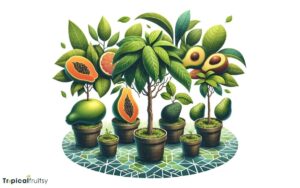Can Kiwi Fruit Grow in Tropical Climate? Explained!
Kiwi fruit can indeed be grown in tropical climates, but it requires careful consideration of the plant’s needs and the implementation of specific agricultural techniques.
By selecting heat-tolerant kiwi varieties and using methods such as controlled irrigation and shade provision, farmers can successfully cultivate kiwi fruit in warmer regions.
Kiwi plants typically thrive in temperate zones, but with adjustments, they can adapt to tropical conditions:
To grow kiwi in the tropics, one might:
- Select heat-tolerant kiwi cultivars.
- Use shade nets to reduce heat stress.
- Implement proper irrigation techniques to manage humidity.
- Employ pruning methods to ensure good air circulation.
Harnessing tropical climates for kiwi cultivation can be viable with the right cultivar selection and innovative farming practices.
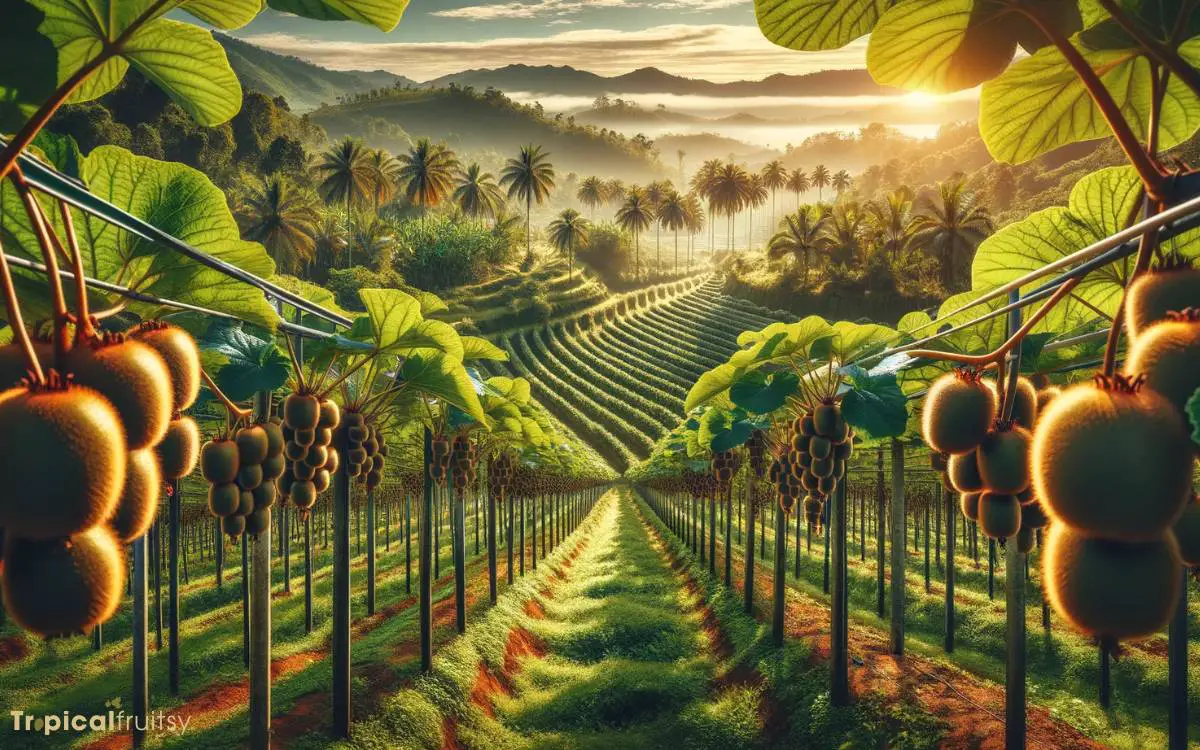
Key Takeaway
8 Factors: Requirement for Kiwi Growth and Adaptation for Tropical Climate
| Factor | Requirement for Kiwi Growth | Adaptation for Tropical Climate |
|---|---|---|
| Climate | Temperate | Use of heat-tolerant cultivars |
| Soil Type | Well-drained | Enhanced drainage systems |
| Soil pH | Acidic to Neutral | Soil amendments as needed |
| Chilling Hours | Required (varies by variety) | Selection of low-chill varieties |
| Heat Tolerance | Moderate | Shade nets and cooling systems |
| Humidity Tolerance | Moderate | Dehumidification techniques |
| Watering | Controlled Irrigation | Drip irrigation systems |
| Disease Management | Fungicide Treatments | Resistant varieties & good air circulation |
Understanding Kiwi Fruit Requirements
Kiwi fruit cultivation necessitates specific climatic conditions, including temperate climates with well-defined winter periods for successful growth and fruit production.
The plant requires a chilling period to break dormancy, a process catalyzed by colder temperatures which is critical for the initiation of bud break and subsequent flowering.
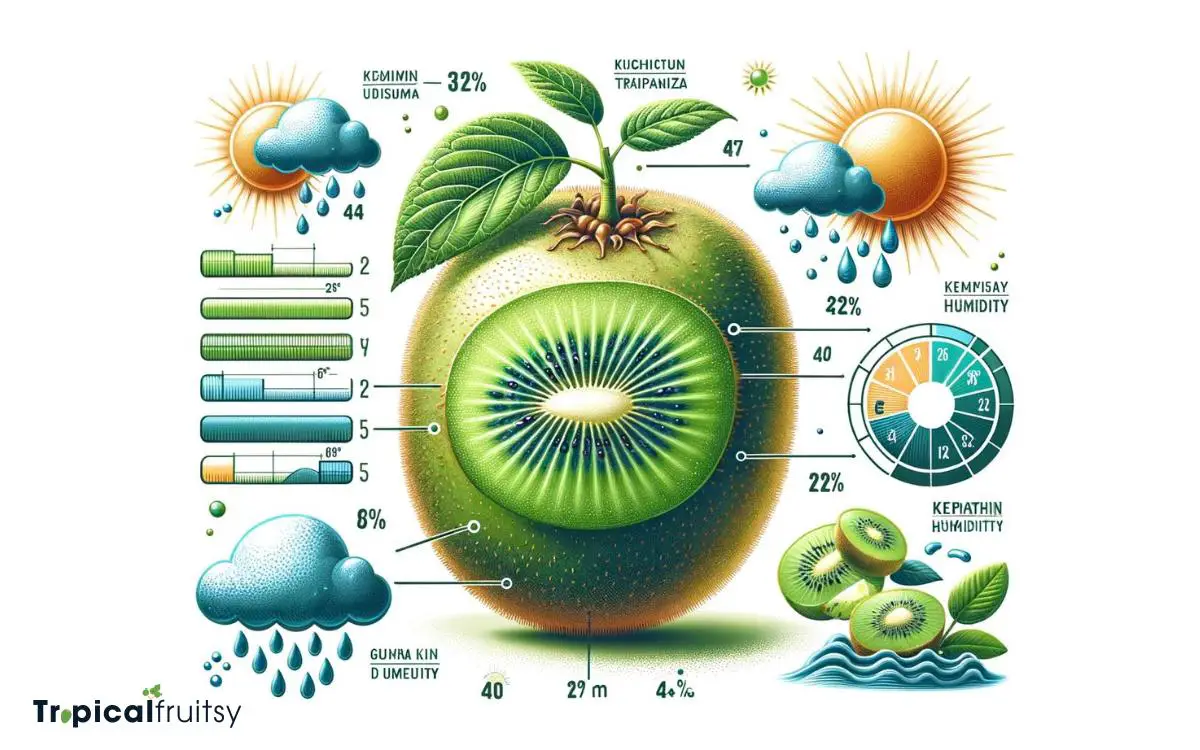
Additionally, kiwi plants are sensitive to frost damage, yet they demand sufficient cold to enter a state of dormancy. An optimal temperature range during growing season fluctuates between 15°C and 25°C.
Soil conditions also play an integral role; kiwi vines thrive in well-draining, slightly acidic soils rich in organic matter. Irrigation management is equally essential to prevent root saturation and ensure adequate moisture during dry spells.
This precise synergy of environmental factors underscores the challenges when considering kiwi cultivation in tropical regions.
Challenges in Tropical Cultivation
Typically, the high temperatures and lack of a distinct winter season inherent to tropical climates present significant obstacles to the cultivation of kiwi fruit.

The specific challenges can be categorized as follows:
- Temperature Regulation: Kiwi plants require chill hours to break dormancy, yet tropical regions often fail to provide the cooler temperatures necessary for this physiological process.
- Pest and Disease Pressure: Elevated temperatures and humidity levels can lead to increased susceptibility to pathogens and pests that thrive in these conditions, potentially compromising plant health and fruit quality.
- Pollination Inefficiencies: The absence of a cold season can disrupt the synchronization between flowering and the availability of pollinators, leading to suboptimal fruit set and yield.
Addressing these challenges requires innovative agronomic strategies and possibly the development of kiwi cultivars better suited to tropical environments.
Selecting Suitable Kiwi Varieties
In response to the cultivation challenges posed by tropical climates, researchers have been focusing on identifying and developing kiwi fruit varieties that demonstrate greater tolerance to heat and limited chill hours.
Selection criteria prioritize genotypes with a reduced vernalization requirement, allowing for successful floral initiation and fruit set under conditions where traditional cultivars would fail.
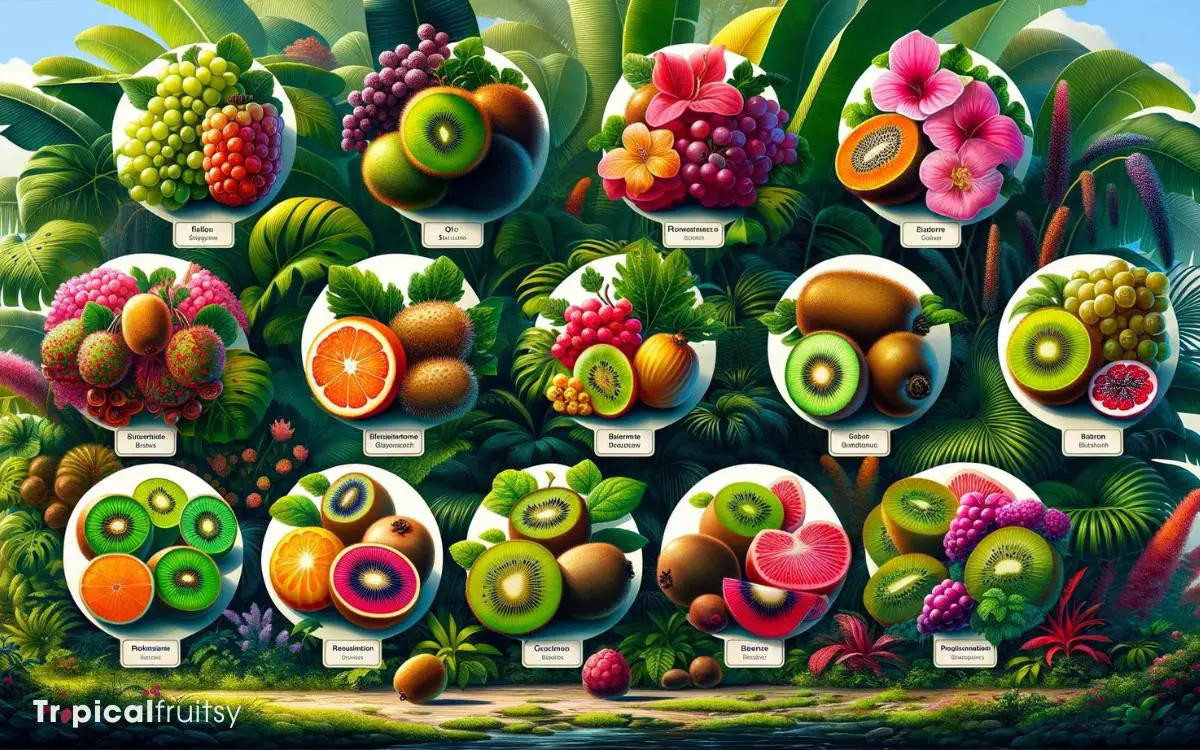
Genetic adaptation to high temperatures is also critical, ensuring that enzyme systems involved in fruit development and ripening maintain functionality.
Cultivars such as ‘Kensington Pride’ and ‘Golden Dragon’ have shown promise in preliminary trials, exhibiting resilience to tropical stressors while maintaining commercially viable fruit quality.
Analytical breeding programs continue to refine these traits through meticulous selection, aiming to expand kiwi cultivation into regions previously deemed unsuitable.
Innovative Growing Techniques
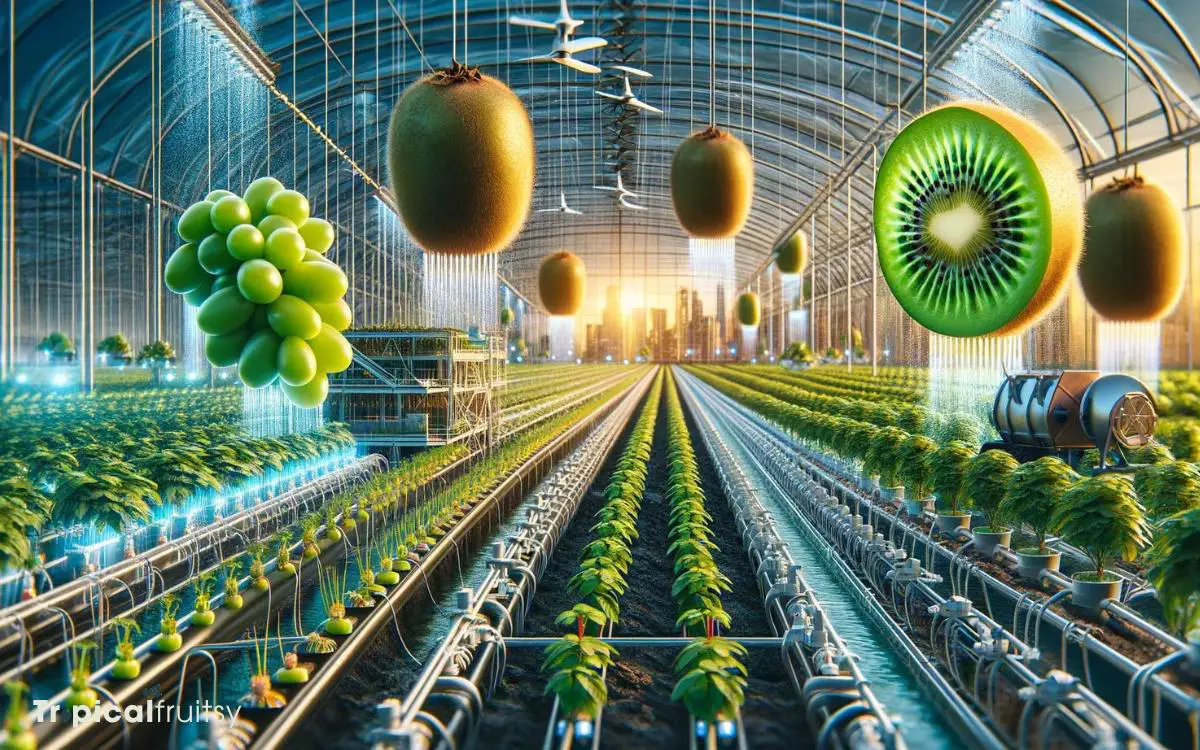
Several innovative growing techniques have been developed to facilitate the cultivation of kiwi fruit in tropical climates, building upon the genetic advancements in heat-tolerant varieties.
These methods are designed to optimize the microclimate around the kiwi plants, ensuring they can thrive despite the challenging environmental conditions.
Key techniques include:
- Controlled Microclimates: Using shade nets and misting systems to reduce temperature and maintain humidity levels conducive to kiwi growth.
- Soil Management: Implementing advanced irrigation practices like drip irrigation to manage water efficiently, along with proper mulching to keep roots cool and moist.
- Pruning and Training: Strategically pruning and training kiwi vines on trellises to maximize air circulation and sun exposure, which is critical for fruit set and quality in tropical regions.
These approaches require careful planning and continuous monitoring to ensure the optimal growing environment for kiwi plants.
What are the Ideal Growing Conditions for Kiwi Fruit in Different Climates?
Kiwi fruit thrive in temperate climates with plenty of sunlight and well-drained soil. In warmer regions, they benefit from partial shade to prevent sunscald. The ideal temperature for growth is between 50-80°F, with higher humidity. Warmer climates can affect fruit size and flavor. Explore the fruit differences to understand the best conditions for cultivating kiwis.
Success Stories and Case Studies
Building upon innovative cultivation techniques, numerous agricultural enterprises have demonstrated successful kiwi fruit production in tropical climates, as evidenced by a range of case studies from around the globe.
These success stories often involve meticulous climate control, strategic varietal selection, and the adoption of advanced agricultural methods such as controlled atmosphere storage and precision irrigation systems.
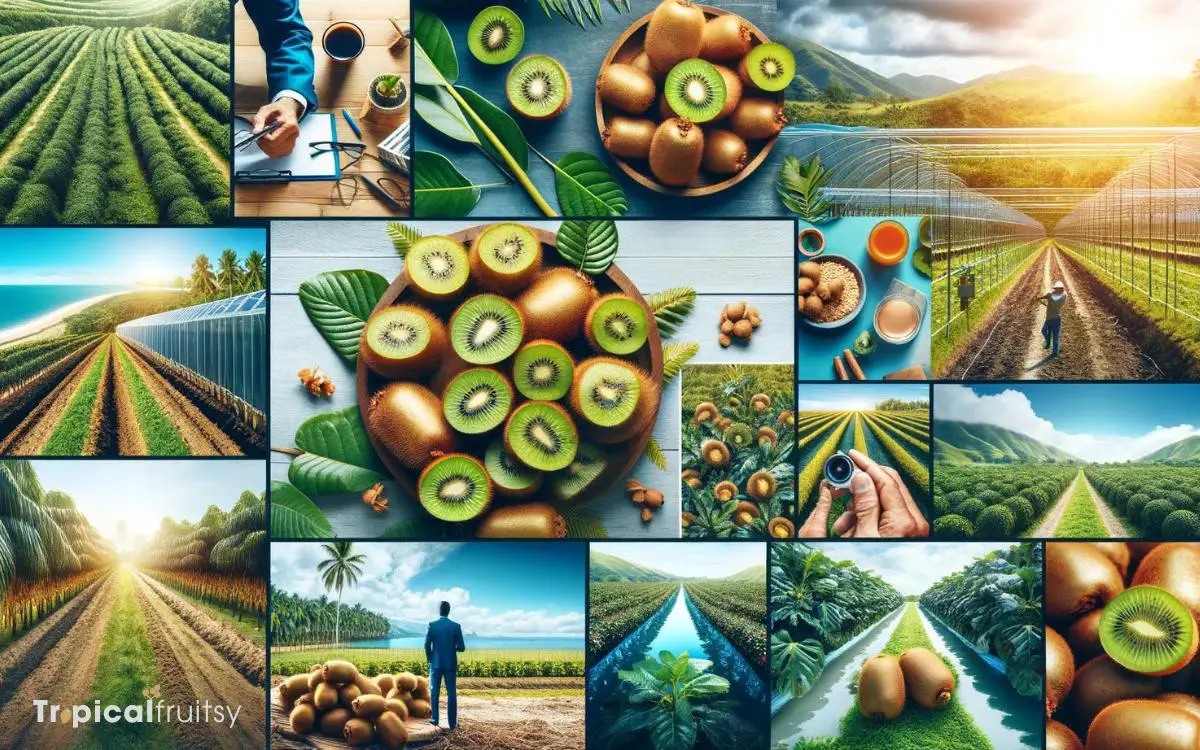
For instance, in Thailand and Vietnam, growers have achieved remarkable yields by implementing modified growing seasons to avoid excessive heat and harnessing microclimate advantages.
Analyzing soil conditions and integrating organic amendments have also been crucial.
These empirical findings underscore the viability of kiwi cultivation in non-traditional settings, offering valuable insights for agronomists and investors seeking to diversify crop portfolios in similar regions.
Conclusion
Successful cultivation of kiwi fruit in tropical climates hinges on meticulous selection of robust varieties and the adoption of innovative horticultural techniques to mitigate environmental challenges.
Case studies demonstrate the feasibility of tropic-adapted kiwi cultivation, heralding a potential paradigm shift in agronomic practices.
This anachronistic endeavor, akin to planting the seeds of temperate flora in the cradle of the sun, underlines humanity’s persistent quest to adapt nature to its needs and desires.



